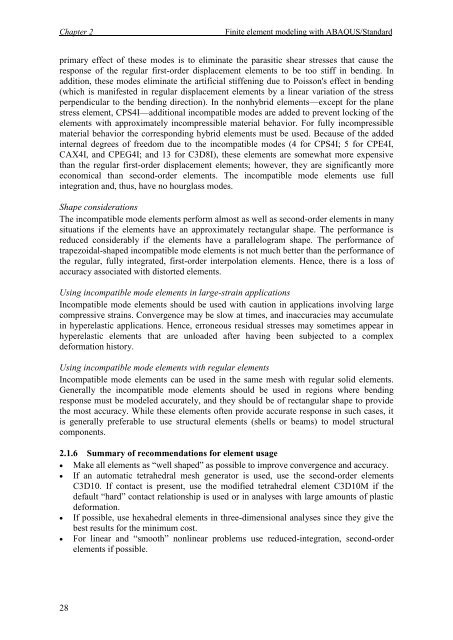Nonlinear Static and Dynamic Analysis of Steel Structures with ...
Nonlinear Static and Dynamic Analysis of Steel Structures with ...
Nonlinear Static and Dynamic Analysis of Steel Structures with ...
You also want an ePaper? Increase the reach of your titles
YUMPU automatically turns print PDFs into web optimized ePapers that Google loves.
Chapter 2 Finite element modeling <strong>with</strong> ABAQUS/St<strong>and</strong>ard<br />
primary effect <strong>of</strong> these modes is to eliminate the parasitic shear stresses that cause the<br />
response <strong>of</strong> the regular first-order displacement elements to be too stiff in bending. In<br />
addition, these modes eliminate the artificial stiffening due to Poisson's effect in bending<br />
(which is manifested in regular displacement elements by a linear variation <strong>of</strong> the stress<br />
perpendicular to the bending direction). In the nonhybrid elements—except for the plane<br />
stress element, CPS4I—additional incompatible modes are added to prevent locking <strong>of</strong> the<br />
elements <strong>with</strong> approximately incompressible material behavior. For fully incompressible<br />
material behavior the corresponding hybrid elements must be used. Because <strong>of</strong> the added<br />
internal degrees <strong>of</strong> freedom due to the incompatible modes (4 for CPS4I; 5 for CPE4I,<br />
CAX4I, <strong>and</strong> CPEG4I; <strong>and</strong> 13 for C3D8I), these elements are somewhat more expensive<br />
than the regular first-order displacement elements; however, they are significantly more<br />
economical than second-order elements. The incompatible mode elements use full<br />
integration <strong>and</strong>, thus, have no hourglass modes.<br />
Shape considerations<br />
The incompatible mode elements perform almost as well as second-order elements in many<br />
situations if the elements have an approximately rectangular shape. The performance is<br />
reduced considerably if the elements have a parallelogram shape. The performance <strong>of</strong><br />
trapezoidal-shaped incompatible mode elements is not much better than the performance <strong>of</strong><br />
the regular, fully integrated, first-order interpolation elements. Hence, there is a loss <strong>of</strong><br />
accuracy associated <strong>with</strong> distorted elements.<br />
Using incompatible mode elements in large-strain applications<br />
Incompatible mode elements should be used <strong>with</strong> caution in applications involving large<br />
compressive strains. Convergence may be slow at times, <strong>and</strong> inaccuracies may accumulate<br />
in hyperelastic applications. Hence, erroneous residual stresses may sometimes appear in<br />
hyperelastic elements that are unloaded after having been subjected to a complex<br />
deformation history.<br />
Using incompatible mode elements <strong>with</strong> regular elements<br />
Incompatible mode elements can be used in the same mesh <strong>with</strong> regular solid elements.<br />
Generally the incompatible mode elements should be used in regions where bending<br />
response must be modeled accurately, <strong>and</strong> they should be <strong>of</strong> rectangular shape to provide<br />
the most accuracy. While these elements <strong>of</strong>ten provide accurate response in such cases, it<br />
is generally preferable to use structural elements (shells or beams) to model structural<br />
components.<br />
2.1.6 Summary <strong>of</strong> recommendations for element usage<br />
Make all elements as ―well shaped‖ as possible to improve convergence <strong>and</strong> accuracy.<br />
If an automatic tetrahedral mesh generator is used, use the second-order elements<br />
C3D10. If contact is present, use the modified tetrahedral element C3D10M if the<br />
default ―hard‖ contact relationship is used or in analyses <strong>with</strong> large amounts <strong>of</strong> plastic<br />
deformation.<br />
If possible, use hexahedral elements in three-dimensional analyses since they give the<br />
best results for the minimum cost.<br />
For linear <strong>and</strong> ―smooth‖ nonlinear problems use reduced-integration, second-order<br />
elements if possible.<br />
28

















